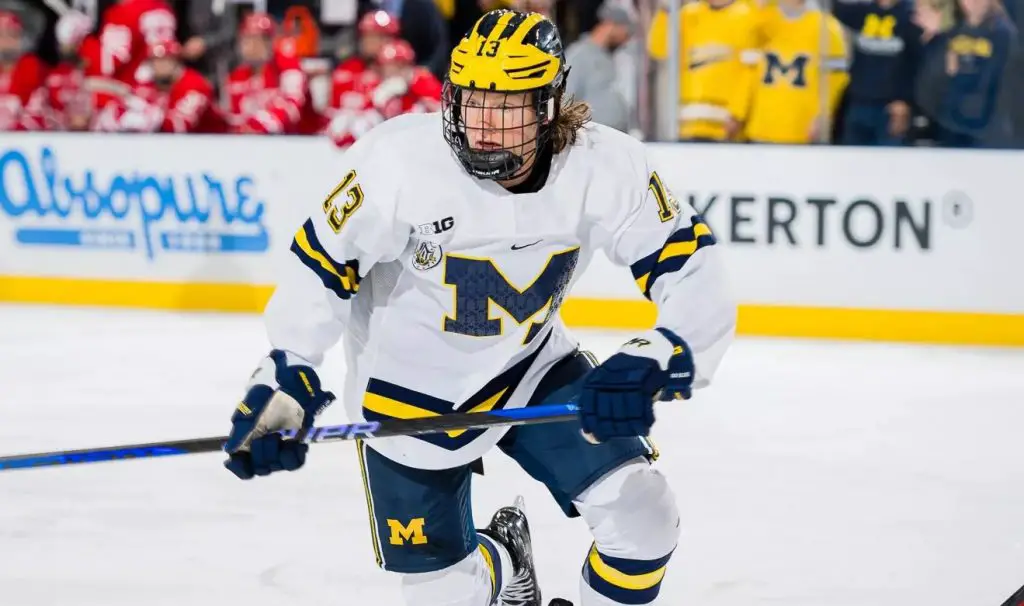
We’re going to vary from the normal USCHO Edge column this week and echo the USCHO Edge podcast in discussing Team Futures in this week’s column.
For those who aren’t familiar with the terminology, a “future bet” is one that you place that is graded on how a team finishes. In major sports like MLB or the NFL, a future has many meanings. Maybe you’re betting on whether a team wins its division. Maybe it has to do with reaching the conference final or, say, winning the American or National League and advancing to baseball’s World Series.
For college hockey, it’s much easier. There is exactly one futures bet – which team will win the national championship.
I call it a simple bet, but I’ll say in the modern betting game, it is actually anything but simple.
Here are some things that matter if you want to try to make a bet on the eventual national champion.
Shopping your bet matters a ton
Any seasoned gambler knows that odds on each and every bet available might vary by the book maker. Nowhere is that more true than on NCAA hockey futures.
Sure, there may be five different books whose odds slightly vary. But when we look at the modern-day sports books, the actual location of the book can significantly sway odds.
There are some states that don’t allow in-state residents to place wagers, including futures wagers – on teams based in their home state. So, let’s take my home state, Massachusetts. If I log into DraftKings, I’m not able to access lines on any Massachusetts teams. So no Boston College, no Boston University, no UMass schools.
Because that takes 12 teams out of the overall equation, the other teams have shorter odds.
Minnesota right now is +700, or 7-to-1, to win the national championships when all teams are available on DraftKings. But in Massachusetts, the Gophers are +600, or 6-to-1.
My point here is that when you’re considering making a play on a future, make sure you’re getting the best possible odds. Compare various online books. If you’re making a trip to a casino that has a sports book, look for longer odds – that is +800 is better odds than +700 because you’ll make $100 more per $100 bet on the higher odds number.
Favorites aren’t always favorable
When Quinnipiac hoisted the national championship trophy last April in Tampa, it’s likely you wouldn’t find too many gamblers holding a ticket on the Bobcats. At one point in the season, Quinnipiac was as high as +3000, meaning a $100 bet if placed with those odds paid $3100 once the Bobcats defeated Minnesota.
The reality is that very few favorites in the month of November go on to be the national champion. The college hockey season is long with ebbs and flows and – above all – plenty of injuries. Teams get on runs in the postseason (see Yale 2013, Providence 2015).
Thus, it is my belief that if you’re looking to make a bet in November, you’re better off trying to look at some early trends and prognosticate a team that might create incredible value (an example outside of hockey is the Texas Rangers, which at one point in August was 60-to-1, or +6000 to win the World Series).
Right now, it’s easy to look at teams that had low expectations but have shown positive signs thus far. Wisconsin, at 7-1-0, was still +3000 as of Monday to win the title. Arizona State, which began 4-0-0 before a loss and tie at Miami, is in the same camp at +4000.
Looking for even longer odds, New Hampshire has been strong against nationally-ranked opponents and sits at +15000. Their border buddies, Maine, have half the odds at +7500, but also have a more recognizable name in the sports books.
The low-cost solution: parlays
Anyone who listens to our podcasts or knows me well, knows I don’t love parlays. Two separate bets will often create one win and one loss. Made individually, those bets pretty much even off. Made in a parlay, you have one solid loser.
But you can create parlays of various futures to wage a tiny amount of money with the hope of a massive payout. This, in my opinion, is really about the entertainment. This of a parlay bet on futures being more like buying a Powerball ticket.
Here, though, is one example of a four-way parlay I built today. Let’s look at four champions: Super Bowl, College Football Playoff, the Final Four and the Frozen Four.
If we couple some favorites together – Kansas City in NFL, Michigan in college football, Kansas in basketball and Michigan in hockey – all four being victorious would pay about +170000. Thus a $10 bet could yield a payout of about $17,000 if all four hit. unlikely yes. But so is winning Powerball, right?
Use this as entertainment, not income
One last thought on futures. Unless you’re gambling through your local bookmaker as opposed to an app or casino, you’re likely putting up the money for your bet in advance. Thus, if you, say, wager $500 on five different college hockey futures, you’re not going to have access to that entire $500 until April.
Additionally, very few “sharps,” or professional gamblers who understand edges, typically on a game-to-game basis, will bet futures with much serious hope to win. These bets are considered fun by even the most serious bettors.
That’s the only approach to a future. Have fun and enjoy and, if you come out with an additional $2000 or so, know you made a good pick – and got lucky!


